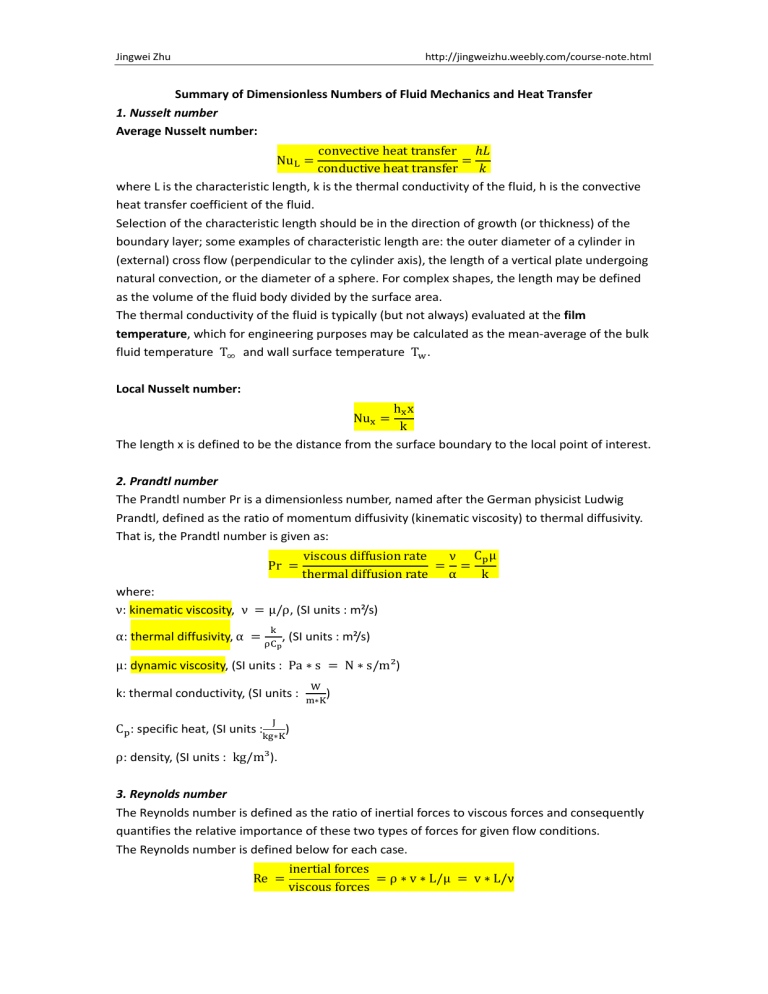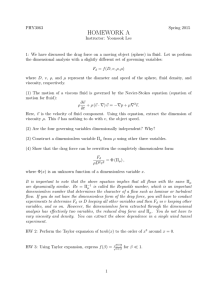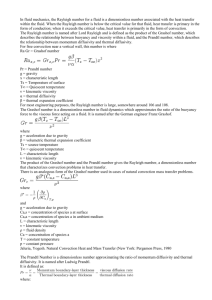
Jingwei Zhu http://jingweizhu.weebly.com/course-note.html Summary of Dimensionless Numbers of Fluid Mechanics and Heat Transfer 1. Nusselt number Average Nusselt number: convective heat transfer ℎ𝐿 = conductive heat transfer 𝑘 where L is the characteristic length, k is the thermal conductivity of the fluid, h is the convective heat transfer coefficient of the fluid. Selection of the characteristic length should be in the direction of growth (or thickness) of the boundary layer; some examples of characteristic length are: the outer diameter of a cylinder in (external) cross flow (perpendicular to the cylinder axis), the length of a vertical plate undergoing natural convection, or the diameter of a sphere. For complex shapes, the length may be defined as the volume of the fluid body divided by the surface area. The thermal conductivity of the fluid is typically (but not always) evaluated at the film temperature, which for engineering purposes may be calculated as the mean-average of the bulk fluid temperature T∞ and wall surface temperature Tw . NuL = Local Nusselt number: hx x k The length x is defined to be the distance from the surface boundary to the local point of interest. Nux = 2. Prandtl number The Prandtl number Pr is a dimensionless number, named after the German physicist Ludwig Prandtl, defined as the ratio of momentum diffusivity (kinematic viscosity) to thermal diffusivity. That is, the Prandtl number is given as: Pr = viscous diffusion rate ν Cp μ = = thermal diffusion rate α k where: ν: kinematic viscosity, ν = μ/ρ, (SI units : m²/s) k α: thermal diffusivity, α = ρC , (SI units : m²/s) p μ: dynamic viscosity, (SI units : Pa ∗ s = N ∗ s/m²) k: thermal conductivity, (SI units : Cp: specific heat, (SI units : J W ) m∗K ) kg∗K ρ: density, (SI units : kg/m³). 3. Reynolds number The Reynolds number is defined as the ratio of inertial forces to viscous forces and consequently quantifies the relative importance of these two types of forces for given flow conditions. The Reynolds number is defined below for each case. Re = inertial forces = ρ ∗ v ∗ L/μ = v ∗ L/ν viscous forces Jingwei Zhu http://jingweizhu.weebly.com/course-note.html where: v is the mean velocity of the object relative to the fluid (SI units: m/s) L is a characteristic linear dimension, (travelled length of the fluid; hydraulic diameter when dealing with river systems) (m) μ is the dynamic viscosity of the fluid (Pa·s or N·s/m² or kg/(m·s)) ν is the kinematic viscosity (ν = μ/ρ) (m²/s) ρ is the density of the fluid (kg/m³). Note that multiplying the Reynolds number by ρLv/ρLv yields ρv 2 L2 /μvL, which is the ratio of the inertial forces to the viscous forces. It could also be considered the ratio of the total momentum transfer to the molecular momentum transfer. While there is no theorem relating the non-dimensional Reynolds number (Re) to turbulence, flows at Reynolds numbers larger than 5000 are typically (but not necessarily) turbulent, while those at low Reynolds numbers usually remain laminar. 4. Péclet number The Péclet number (Pe) is a dimensionless number relevant in the study of transport phenomena in fluid flows. It is defined to be the ratio of the rate of advection of a physical quantity by the flow to the rate of diffusion of the same quantity driven by an appropriate gradient. The Péclet number is defined as: advective transport rate Pe = diffusive transport rate For diffusion of matter (mass diffusion), it is defined as: U = ReL /Sc D For diffusion of heat (thermal diffusion), the Péclet number is defined as: PeL = L ∗ U/α = ReL /Pr where L is the characteristic length, U the velocity, D the mass diffusion coefficient, and α the PeL = L ∗ k thermal diffusivity, α = ρ∗C p where k is the thermal conductivity, ρ the density, and Cp the heat capacity. Side note Fick’s first law: the flux goes from regions of high concentration to regions of low concentration, with a magnitude that is proportional to the concentration gradient (spatial derivative), or in simplistic terms the concept that a solute will move from a region of high concentration to a region of low concentration across a concentration gradient. In one (spatial) dimension, the law is: ∂φ ∂x where J is the "diffusion flux" [(amount of substance) per unit area per unit time], for example J = −D mol (m2 𝑠). J measures the amount of substance that will flow through a small area during a small time interval. D is the diffusion coefficient or diffusivity in dimensions of [length2 time−1], for example ( m2 s ). φ (for ideal mixtures) is the concentration in dimensions of [amount of substance per unit Jingwei Zhu http://jingweizhu.weebly.com/course-note.html mol volume], for example ( m3 ). x is the position [length], for example m. 5. Stanton number The Stanton number, St, is a dimensionless number that measures the ratio of heat transferred into a fluid to the thermal capacity of fluid. It is used to characterize heat transfer in forced convection flows. h h St = = G ∗ Cp ρ ∗ u ∗ Cp where: h = convection heat transfer coefficient ρ = density of the fluid Cp = specific heat of the fluid u = speed of the fluid It can also be represented in terms of the fluid's Nusselt, Reynolds, and Prandtl numbers: St = Nu Re ∗ Pr where: Nu is the Nusselt number; Re is the Reynolds number; Pr is the Prandtl number. 6. Mach number In fluid mechanics, Mach number (M or Ma) is a dimensionless quantity representing the ratio of speed of an object moving through a fluid and the local speed of sound. M = vobject /vsound where: M is the Mach number, vobject is the velocity of the source relative to the medium, and vsound is the speed of sound in the medium. 7. Schmidt number Schmidt number (Sc) is a dimensionless number defined as the ratio of momentum diffusivity (viscosity) and mass diffusivity, and is used to characterize fluid flows in which there are simultaneous momentum and mass diffusion convection processes. It is defined as: ν μ Sc = = = viscous diffusion rate/molecular (mass) diffusion rate D ρ∗D where: ν is the kinematic viscosity or (mu/rho) in units of (m²/s) D is the mass diffusivity (m²/s). μ is the dynamic viscosity of the fluid (Pa·s or N·s/m² or kg/m·s) ρ is the density of the fluid (kg/m³). The heat transfer analog of the Schmidt number is the Prandtl number. Jingwei Zhu http://jingweizhu.weebly.com/course-note.html 8. Biot number The Biot number (Bi) is a dimensionless quantity used in heat transfer calculations. It gives a simple index of the ratio of the heat transfer resistances inside of and at the surface of a body. The Biot number is defined as: Lc Bi = h ∗ kb where: h = film coefficient or heat transfer coefficient or convective heat transfer coefficient Lc = characteristic length, which is commonly defined as the volume of the body divided by the surface area of the body, such that Vbody Lc = Asurface k b = Thermal conductivity of the body 9. Rayleigh number In fluid mechanics, the Rayleigh number (Ra) for a fluid is a dimensionless number associated with buoyancy driven flow (also known as free convection or natural convection). When the Rayleigh number is below the critical value for that fluid, heat transfer is primarily in the form of conduction; when it exceeds the critical value, heat transfer is primarily in the form of convection. The Rayleigh number is defined as the product of the Grashof number, which describes the relationship between buoyancy and viscosity within a fluid, and the Prandtl number, which describes the relationship between momentum diffusivity and thermal diffusivity. Hence the Rayleigh number itself may also be viewed as the ratio of buoyancy and viscosity forces times the ratio of momentum and thermal diffusivities. For free convection near a vertical wall, the Rayleigh number is defined as Rax = 𝑔𝛽 ∗ (𝑇𝑠 − 𝑇∞ )𝑥 3 = 𝐺𝑟𝑥 𝑃𝑟 𝜈𝛼 where: x = Characteristic length (in this case, the distance from the leading edge) Rax = Rayleigh number at position x Grx = Grashof number at position x Pr = Prandtl number g = acceleration due to gravity Ts = Surface temperature (temperature of the wall) T∞ = Quiescent temperature (fluid temperature far from the surface of the object) ν = Kinematic viscosity α = Thermal diffusivity β = Thermal expansion coefficient (equals to 1/T, for ideal gases, where T is absolute temperature) In the above, the fluid properties Pr, ν, α and β are evaluated at the film temperature, which is defined as Tf = Ts + T∞ 2 Jingwei Zhu http://jingweizhu.weebly.com/course-note.html For most engineering purposes, the Rayleigh number is large, somewhere around 10E6 to 10E8. For a uniform wall heating flux, the modified Rayleigh number is defined as Ra∗x = g ∗ β ∗ q′′o ∗ x 4 /(ν ∗ α ∗ k) where: q′′o = the uniform surface heat flux (W/m2) k = the thermal conductivity (W/m*K) 10. Grashof number The Grashof number (Gr) is a dimensionless number in fluid dynamics and heat transfer which approximates the ratio of the buoyancy to viscous force acting on a fluid. It frequently arises in the study of situations involving natural convection. GrL = gβ(Ts − T∞ )L3 /ν2 for vertical flat plates GrD = gβ(Ts − T∞ )D³/ν2 for pipes GrD = gβ(Ts − T∞ )D3/ν2 for bluff bodies where the L and D subscripts indicate the length scale basis for the Grashof Number. g = acceleration due to Earth's gravity β = volumetric thermal expansion coefficient (equal to approximately 1/T, for ideal fluids, where T is absolute temperature) Ts = surface temperature T∞ = bulk temperature L = characteristic length D = diameter ν = kinematic viscosity The transition to turbulent flow occurs in the range 10E8<GrL<10E9 for natural convection from vertical flat plates. At higher Grashof numbers, the boundary layer is turbulent; at lower Grashof numbers, the boundary layer is laminar. The product of the Grashof number and the Prandtl number gives the Rayleigh number, a dimensionless number that characterizes convection problems in heat transfer. 11. Skin Friction Coefficient The skin friction coefficient, Cf , is defined by Cf = τw 1 2 ∗ 𝜌𝑈∞ 2 where τw is the local wall shear stress, ρ is the fluid density and U∞ is the free stream velocity (usually taken outside of the boundary layer or at the inlet). 12. Drag Coefficient In fluid dynamics, the drag coefficient (commonly denoted as: Cd) is a dimensionless quantity that is used to quantify the drag or resistance of an object in a fluid environment, such as air or water. It is used in the drag equation, where a lower drag coefficient indicates the object will have less aerodynamic or hydrodynamic drag. The drag coefficient is always associated with a particular surface area. Jingwei Zhu http://jingweizhu.weebly.com/course-note.html The drag coefficient of any object comprises the effects of the two basic contributors to fluid dynamic drag: skin friction and form drag. The drag coefficient of a lifting airfoil or hydrofoil also includes the effects of lift-induced drag. The drag coefficient of a complete structure such as an aircraft also includes the effects of interference drag. The drag coefficient Cd is defined as Cd = Fd 1 2 2 ∗ 𝜌𝑣 𝐴 where: Fd is the drag force, which is by definition the force component in the direction of the flow velocity, ρ is the density of the fluid, v is the speed of the object relative to the fluid, A is the reference area. The reference area depends on what type of drag coefficient is being measured. For automobiles and many other objects, the reference area is the projected frontal area of the vehicle. This may not necessarily be the cross sectional area of the vehicle, depending on where the cross section is taken. For example, for a sphere A = π r2 , (note this is not the surface area = 4 π r2 ). For airfoils, the reference area is the planform area. Since this tends to be a rather large area compared to the projected frontal area, the resulting drag coefficients tend to be low: much lower than for a car with the same drag and frontal area, and at the same speed. Airships and some bodies of revolution use the volumetric drag coefficient, in which the reference area is the square of the cube root of the airship volume (volume to the two-thirds power). Submerged streamlined bodies use the wetted surface area. Two objects having the same reference area moving at the same speed through a fluid will experience a drag force proportional to their respective drag coefficients. Coefficients for unstreamlined objects can be 1 or more, for streamlined objects much less. 13. Eckert Number The Eckert number (Ec) is a dimensionless number used in continuum mechanics. It expresses the relationship between a flow's kinetic energy and enthalpy, and is used to characterize dissipation. It is defined as u2 Ec = Cp ∆𝑇 where: u is the local flow velocity of the continuum, Cp is the constant pressure local specific heat of the continuum, ∆T = Ts − 𝑇∞ is the temperature difference between the surface and the free stream. 14. Fourier Number In physics and engineering, the Fourier number (Fo) or Fourier modulus, named after Joseph Fourier, is a dimensionless number that characterizes heat conduction. Together with the Biot number, it characterizes transient conduction problems. Conceptually, it is the ratio of diffusive/conductive transport rate by the quantity storage rate and arises from Jingwei Zhu http://jingweizhu.weebly.com/course-note.html non-dimensionalization of the heat equation. The transported quantity is usually either heat or matter (particles). The general Fourier number is defined as: diffusive transport rate Fo = storage rate The thermal Fourier number is defined by the conduction rate to the rate of thermal energy storage. Foh = αt L2 where: α is the thermal diffusivity [m2 /s] t is the characteristic time [s] L is the length through which conduction occurs [m] For transient mass transfer by diffusion, there is an analogous mass Fourier Number (also denoted Fo) defined as: Fom = 𝐷𝑡 𝐿2 where: D is the diffusivity [m2 /s] t is the characteristic timescale [s] L is the length scale of interest [m] 15. Jakob Number The Jakob number (Ja) is the ratio of sensible to latent energy absorbed during liquid-vapor phase change. It is defined as: Ja = Cp (𝑇𝑠 − 𝑇𝑠𝑎𝑡 )/∆ℎ𝑓 Ts − 𝑇𝑠𝑎𝑡 is the temperature difference, Cp is the constant pressure local specific heat, ∆hf is the evaporation enthalpy change. 16. Lewis Number Lewis number (Le) is a dimensionless number defined as the ratio of thermal diffusivity to mass diffusivity. It is used to characterize fluid flows where there is simultaneous heat and mass transfer by convection. It is defined as: α Le = D where α is the thermal diffusivity and D is the mass diffusivity. The Lewis number can also be expressed in terms of the Schmidt number and the Prandtl number: Le = Sc/Pr




